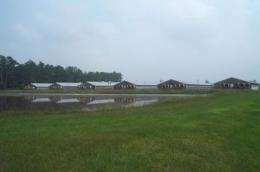Environmental impact of animal waste

North and South Carolina have seen a steady increase in swine production over the last 15 years. In North Carolina alone, swine production generates approximately a quarter of the state's gross farm receipts. The presence of so many large-scale pig farms leads to the problem of proper animal waste disposal.
The most common practice in the Carolinas is storing animal waste in anaerobic lagoons. They are primarily used to concentrate and passively treat urine and feces but because of the widespread use of this practice, the environmental impact could be quite severe. Conflicting reports implicate lagoon sites to be responsible for high emission rates of nitrogen gas and volatized ammonia.
A team of ARS-USDA scientistsexamined a series of commercial, anaerobic, swine wastewater lagoons in North and South Carolina for genes involved in the nitrogen cycling process. Nitrification and denitrification are the parts of the process responsible for turning ammonia into nitrogen gas. After analyzing eight lagoons and measuring the abundance of four nitrogen cycling genes, researchers concluded that the denitrifying and nitrifying organisms were not active despite there being a thriving amount. Acidification and eutrophication of the surrounding ecosystem could be the result of prolonged exposure to volatilized ammonia.
Thomas F. Ducey, one of the authors of the study says, "These anaerobic lagoons have relatively consistent levels of nitrogen-cycling genes throughout their water column. While they are similar to natural ecosystems, they are not as high as some wastewater treatment system. Moreover, these gene levels did not translate into the high denitrification enzyme activity that is typical of wastewater treatment systems."
Ducey adds, "The work is part of the ARS Agricultural and Industrial Byproducts National Program, which has the mission to effectively and safely manage and use manure and other agricultural and industrial byproducts in ways that maximize their potential benefits while protecting the environment and human and animal health."
More information: The full study can be found in the March/April 2011 issue of the Journal of Environmental Quality.
Provided by American Society of Agronomy















